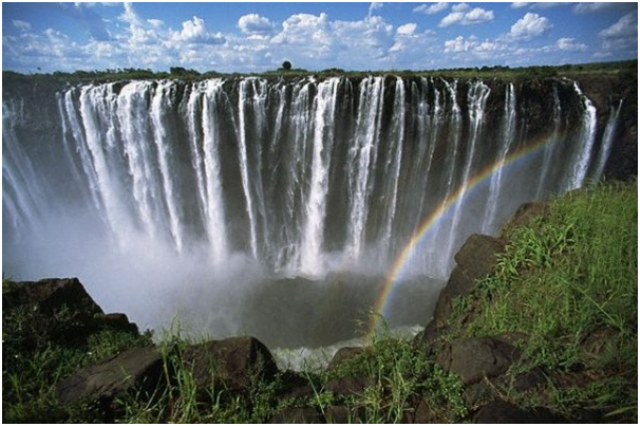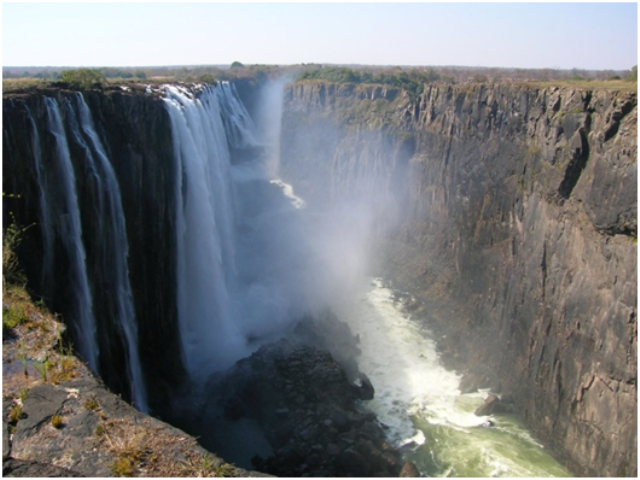The Victoria Falls are one of the most spectacular natural wonders of the worlds. The local people call it ‘Mosi-oa-tuniya’ or the ‘smoke that thunders’. There is something truly magical in the towering column of spray, the thunder of the falling water, the terrifying abyss, and tranquil lagoons upstream in which hippos and deadly crocodiles lurk.
The Victoria falls is 1,708 mt. wide, making it the largest curtain of water in the world. It drops between 90 mt. and 107 mt. into the Zambezi Gorge, and an average of 5,50,000 cubic metres of water plummet over the edge every minute. The spray from the falls typically rises to a height of over 400 metres, and sometimes even twice as high, and is visible from up to 50 km. away. During the flood season, however, it is impossible to see the foot of the falls. Most of the falls, and the walks along the cliff opposite it are in a constant shower and shrouded in mist. Close to the edge of the cliff, spray shoots upward like inverted rain, making them seem more like a cloud of vapour rather than a waterfall.
The people of Mukuni called Toka-Leya have lived around the Victoria Falls from time immemorial. Living so close to the Victoria Falls, the Toka-Leya understand better the waterfall- and revere it too. As a result, many shrines have been created for different purposes, including prayers and sacrifices. This stems from the belief that a no. of spirits live around the area surrounding the falls.
Infact, the area was a sacred site for the Batoka and other local tribes too. Victoria Falls is made of five different ‘falls’. Four of these are in Zimbabwe. they are the Devil’s Cataract, Main Falls, Rainbow Falls and Horseshoe Falls- and one, the Eastern Cataract, is in the bordering country of Zambia. The Rainbow Falls get their names from the brilliant rainbows that are created by sunlight passing through the water. The lunar rainbow can also be seen on full moon nights, as the moon rises and its rays pass through the curtain of the glistening water. The Tonga regarded the rainbows created by the falls as God’s presence, while the Kololo people held it in such awe that they never went anywhere near the falls.
Being one of the seven natural wonders of the world, it attracted many explorers. In 1855, the British explorer David Livingstone thrilled the world by reaching the Victoria Falls. On the 17th of November 1855, Chief Sekeletu of the Makololo tribe paddled Livingstone to an island in the Zambezi, known as the Goat Island. Although the water was low at the time, he felt a ‘tremor of fear’ as he approached the wall of spray. The sensitive Scotsman was so overwhelmed by his first sight of these spectacular falls, that he momentarily abandoned his scientific observations and recorded: “It has never been seen before by European eyes, but scenes so wonderful must have been gazed upon by angels in their flight”. This famous missionary, whose heart lies buried in Africa, loyally named this great wonder of the world after Victoria, his British Queen.
It’s said that the Victoria falls are very retreating and losing ground. During the Jurassic period, about 150 to 200 million years ago, volcanic activity resulted in thick basalt deposits covering large parts of Southern Africa. As the lava cooled, and solidified, cracks appeared in the hard basalt crust, which was filled with clay and lime. Erosion, and the course of the mighty Zambezi river cut through these softer materials forming the first series of waterfalls. However, over 2,000 years, the Falls have receded eight km. upstream, as the Zambezi carved its way through seven gorges.
But though the falls are retreating, they are still one and a half times wider than the Niagara Falls, and twice its height, making Victoria Falls the biggest curtain of gushing water in the world.
BY AISHWARYA IYER








7 Comments